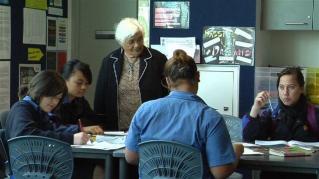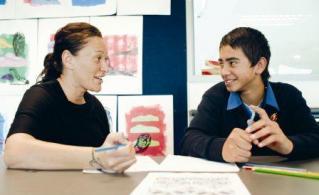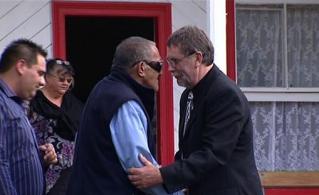Transcript
Robbie Lamont – Facilitator, Kerikeri High School
The most profound way to create a culturally responsive context, is through introducing co-construction, where the child, or the student, or the learner is free to bring their own experiences into that classroom context. Those experiences have validity, they are valued, and they become part of the process of what goes on in the classroom.
Chevy, student – Kerikeri High School
He’s a Māori, born in Gisborne in 1944. Loves bread and butter, typical Māori. Author of The Whale Rider and many other novels, and was the first Māori to have a novel published.
Thelma Moke – Teacher, Kerikeri High School
That came about as a follow-on from a research project that we had done in Te Reo Māori. And she was still passionate about learning about Witi Ihimaera. And when she had learned some things about him, she wanted to be able to show the funny side, or the side that her peers – her audience - can relate to.
Chevy – Kerikeri High School
Even as a young boy he was very interested in writing. He was so interested that he recalls scrawling stories across the whole wall of his room. Imagine what his Mum said about that – actually it’s a wonder he’s still alive!
Robbie Lamont
Culturally responsive is a much more, I guess, complex process. More about the responsiveness to that individual student who has cultural capital or cultural background, a cultural heritage, a cultural past, which isn’t necessarily always what one would call traditional.
Lorraine Williamson – Principal, Opunake Primary School
If we are looking at a topic, we will often specifically include a component of Māori in there. So as with the bush survival, when we have opportunities we will use people like Whaea Mahara to come and talk to students. And it’s like with literacy, we say that it’s really important for people to see images of themselves.
Wally Penetito – Lecturer, Victoria University of Wellington
It’s always going to need community participation because some of the experts that are needed to convey the learning, to provide the knowledge, is going to be in that community. Teachers are not going to have it. Teachers will have certain kinds of knowledge which they are expert in, and that’s part of their training and part of the experience. But communities belong to the people that are there, and they are the best ones to provide that connection.
Lorraine Williamson
The component of this unit is looking at safety in our local bush area. And how we would survive if something happened to us if we were out walking with our whānau or we were on a school trip.
Kay Mourie – Teacher, Opunake Primary School
The last unit we did we looked at ‘the creation myths’, we called them. And we looked at the Māori perspective, and then we looked at perhaps the Hebrew, or the children selected different ones. Several of the children came back and said: “When I was talking about this with my Mum, she said such and such”, you know – and that was say the Rangi and Papa story.
Claire McLean and Richard Travers – Parents, Opunake Primary School
As far as the teaching and the cultures go, there’s a much bigger improvement in balance.
Kerry Walsh – Parent, Opunake Primary School
The thing is too that it’s subtle. It’s not in your face, you know, because there are also non-Māori families at this school.
Kay Mourie
You’re bringing the Māori perspective into things, in everything. So it’s in your written language, it’s in your reading. It just sits at the bottom of everything. It’s not a stand alone: “Let’s do Māori”.
Robbie Lamont
I think sometimes one of the risks that is inherent in the whole process – I think particularly for Pakeha teachers – of that journey towards cultural appropriateness and culturally responsive, is the risk of tokenism. And many Pakeha teachers that we have worked with are particularly afraid of becoming….of being culturally tokenistic, I suppose. That it isn’t enough for them to put a few kowhaiwhai patterns around the whiteboard.





